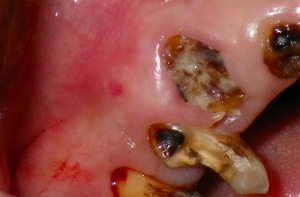Although dental hygienists in BC are not allowed to prescribe any medications including at-home chlorhexidine (CHX) rinses, collaborating with other dental professionals to prescribe CHX rinse needs to be adopted in dental hygiene profession. I had noticed many of my
colleagues not working with dentists to prescribe CHX rinse in active periodontitis cases due to lack of time and fear of adverse of effect of CHX rinse – staining. For my practice, if I recognized any symptoms for oral infections, aggressive periodontitis, and uncontrolled chronic periodontitis, I worked with a dentist to make sure that clients would have in-home CHX treatment. All the clients were advised the appropriate use of CHX rinse, especially use it less than 2 weeks to prevent from getting stains. All the clients reported that they felt their oral pain/discomfort had subsidized from using in-home CHX rinse. I had a case in which the client had multiple caries, abscesses, and aggressive periodontitis. I helped him to receive in-home CHX rinse as soon as possible and his oral pain had significantly subsidized and his periodontitis had been relatively stable. I had prevented possible oral infections and stabilized progression of oral diseases using an appropriate use of in-home CHX rinse.


